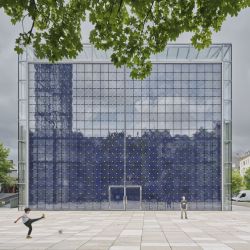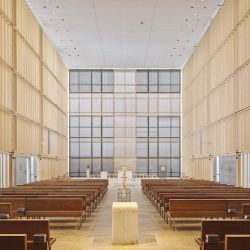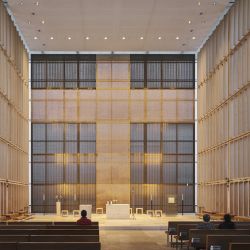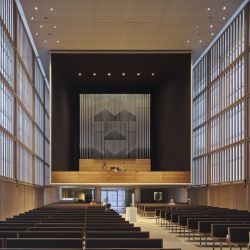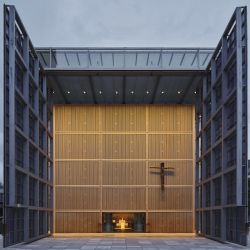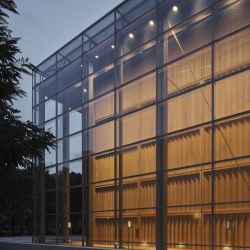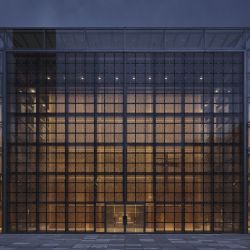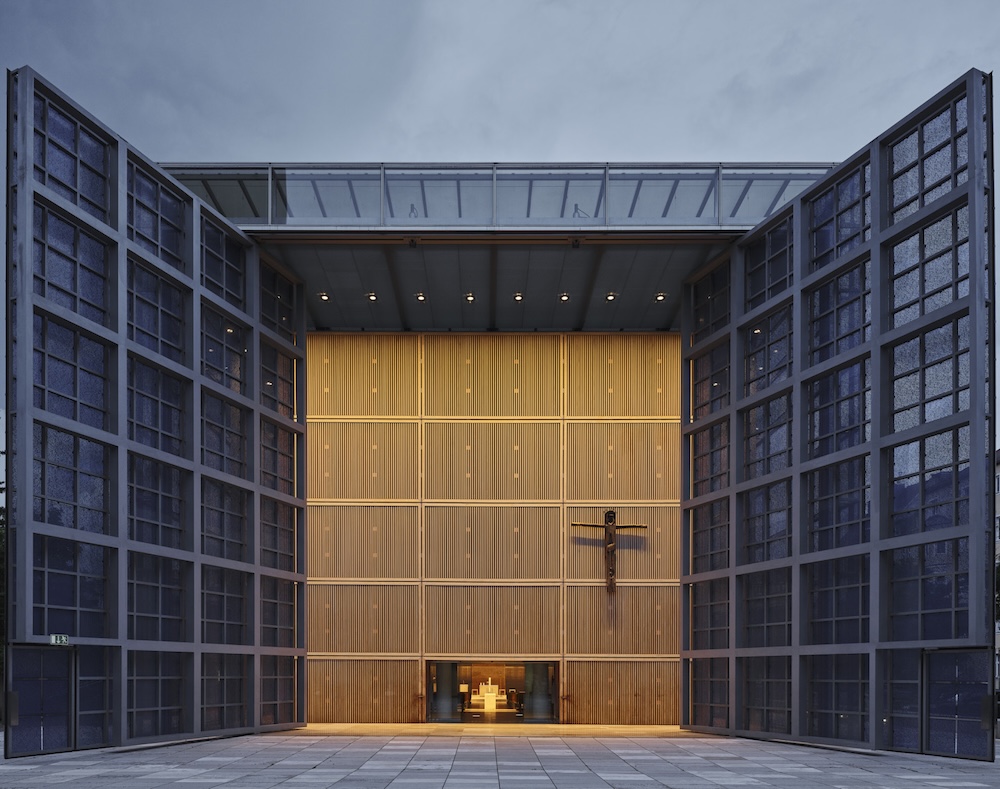
Download this article:
There are such things as "instant classics": buildings whose lasting significance is evident from the moment they are built. Herz Jesu Kirche in Munich is one of them. When it opened in 2000, the contemporary sacred building caused a sensation and catapulted Munich architectural practice Allmann Sattler Wappner onto the international stage. A new LED scheme now saves up to 90% energy, allows seamless dimming down to 0.1% and ensures flicker-free operation suitable for video.
For the original lighting design, the parish enlisted George Sexton - a luminary in the field - whose US background would later prove significant. ERCO supplied the sophisticated lighting technology. As corporate magazine Lichtbericht 66 put it at the time: "Light is the classic architectural metaphor for spirituality; its modulation serves as a leitmotif for the building."
A statement as apt today as it was 25 years ago. Today, in Munich's Neuhausen district, Herz Jesu Church is first and foremost the centre of a vibrant parish; its rich concert programme attracts culture-lovers from the city and beyond. It is also a pilgrimage site for architecture aficionados and, with what is reputed to be the world's largest church portal, a genuine tourist attraction. Visitors encounter a pared-back, cubic volume of steel and glass that protectively envelops an inner timber "box" - the actual church space. The two layers filter the daylight in different ways: the glass façade, with a gradient of frosting, shifts the interior light from clear to diffuse, while the timber louvres open towards the altar so that brightness increases as one progresses through the church. By night, the artificial lighting reverses these effects, transforming the church into a shimmering "rock crystal", as the architects described it.
Timeless lighting concept - obsolete lamps
Sexton worked with the high-end tools of his time: lens wallwashers for uniform illumination of vertical surfaces, and recessed spotlights with deep cut-off for general illumination of horizontal planes and for accents on areas such as the choir and altar. True to his exacting standards, he specified lamps that produced beautifully warm, velvety, perfectly dimmable light. However, as lighting designer Prof. Michael Schmidt, who oversaw and coordinated the recent refurbishment, explains: "Sexton used US 120 V halogen reflector lamps back then, which did give us a few headaches." Those now-obsolete lamps consumed a great deal of energy, wore out quickly, needed frequent replacement - and are simply no longer available. Relighting with contemporary LED technology was therefore unavoidable - a step that promised substantial long-term reductions in energy and maintenance costs.
Given the lighting's integral role in both architecture and liturgy, a like-for-like replacement of the luminaires, while preserving the original lighting concept as far as possible, was the only viable approach. Who better to undertake it than the supplier of the original equipment? On this basis, ERCO was invited to demonstrate the capabilities of modern LED luminaires in an on-site mock-up. "We managed to meet the demanding brief with just four luminaire types from our standard range," reports Mariusz Furtak, Regional Manager of ERCO's Munich branch. Atrium LED lens wallwashers and Quinta directional spotlights with three light distributions achieved an effect at 2700 K that closely matched the original - at only 10-15% of the connected load. They also fitted the existing recesses with virtually no alteration.
Like-for-like LED replacement saves up to 90% energy
With the performance proven, the decision in favour of ERCO was clear. The next hurdle concerned control and cabling. "Separate dimmer cabinets for the 120 V lamps were installed in the church's equipment room for the various circuits," says Schmidt. It also had to be clarified whether the original cabling - with unusually large conductor cross-sections due to the high loads - could continue to be used. As the church's lofty ceiling and construction made retrofitting additional control lines impractical, the new system had to be wireless. ERCO proposed a Casambi Bluetooth solution that operates smoothly with around 200 nodes.
After successful installation, the electricians first recreated the original lighting scenes designed by George Sexton. The user-friendly Casambi app also allows authorised users to adjust scenes themselves as needed. Additional scenes can be created, and targeted accents set by addressing individual luminaires or freely defined groups - for example, highlighting the baptismal font or the organ. The system is operated via a tablet stationed in the church and via the app on authorised smartphones. A single tap is enough to adapt the lighting to natural conditions that change with time of day and weather, as well as to different situations and occasions.
Wireless control for more convenience and flexibility
In operation, the ERCO LED luminaires impress with their homogeneous illumination and with special capabilities such as seamless dimming down to 0.1% and flicker-free performance suitable for television - which is important because services are regularly broadcast. "The laborious maintenance with the cherry picker and the hunt for replacement lamps are now a thing of the past. And by consuming less electricity, we are doing our part to protect the environment," says Dr Konstantin Bischoff, pastoral advisor and head of the parish. "The lighting effect is almost more beautiful than before, and the control for our diverse uses is certainly better and more flexible." With this thoroughly successful lighting refurbishment, Herz Jesu Church follows the example of historic churches that have been continually cared for by their builders - achieving timelessness through steady, organic renewal.
| Project Data | |
|---|---|
| Project: | Herz Jesu Church, Munich, Germany |
| Client: | Catholic parish Herz Jesu Munich |
| Architecture: | Allmann Wappner Architekten, Munich |
| Lighting design: | George Sexton / Michael Schmidt |
| Electrical engineering: | Planungsgesellschaft Silberbauer GmbH & Co. KG, Haag an der Amper |
| Electrical installation: | Elektro Rossmanith, Munich |
| Products: | Atrium double focus wallwasher, Quinta spotlights |
| Photo credits: | © ERCO GmbH, www.erco.com |
| Photography: | David Schreyer |
About ERCO
ERCO is an international specialist for high-quality and digital architectural lighting. The family-owned company, founded in 1934, operates globally in 55 countries with independent sales organisations and partners.
ERCO understands light as the fourth dimension of architecture – and thus as an integral part of sustainable building. Light is the contribution to making society and architecture better and, at the same time, preserving our environment. ERCO Greenology® – the corporate strategy for sustainable lighting – combines ecological responsibility with technological expertise.
At the light factory in Lüdenscheid, Germany, ERCO develops, designs and manufactures luminaires with a focus on photometric optics, electronics and sustainable design. The lighting tools are developed in close collaboration with architects, lighting designers and electrical designers. They are used primarily in the following applications: Work and Culture, Community and Public/Outdoor, Contemplation, Living, Shop and Hospitality. ERCO lighting experts support designers worldwide in transforming their projects into reality with highly precise, efficient and sustainable lighting solutions.
If you require any further information on ERCO or image material, please visit us at www.erco.com/press. We can also provide you with material on projects worldwide for your media coverage.
Relevant image material
© ERCO GmbH, www.erco.com, Photography: David Schreyer
© ERCO GmbH, www.erco.com, Photography: David Schreyer
© ERCO GmbH, www.erco.com, Photography: David Schreyer
© ERCO GmbH, www.erco.com, Photography: David Schreyer
© ERCO GmbH, www.erco.com, Photography: David Schreyer
© ERCO GmbH, www.erco.com, Photography: David Schreyer
© ERCO GmbH, www.erco.com, Photography: David Schreyer
